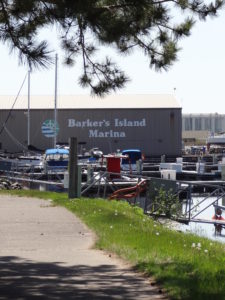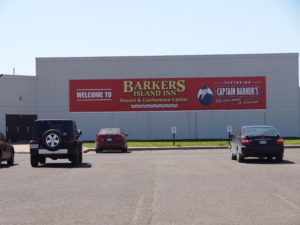Barker’s Island in Superior looks different than it did a year ago. Construction on the island’s public beach rearranged and added structures to help improve water quality and provide a better experience for swimmers.
More changes are in store for the next two summers, all designed to reduce stormwater runoff and protect water quality in the Superior Bay and ultimately, Lake Superior.
Conceptual designs were recently completed for work at the Barker’s Island Marina and will be completed in 2020 for areas around Barker’s Island Inn, thanks to several grants and cooperation among the two businesses and Sea Grant programs in Wisconsin, Michigan, and Ohio, as well as the City of Superior, the Wisconsin Coastal Management Program, The Ohio State University, and the Wisconsin Marine Association.
Three projects at the marina will begin work this summer. Four others at the inn will begin in 2021. Here’s the rundown.

Barker’s Island Marina will be updated in 2020 with a stormwater wetland. The project will treat runoff from the service area and parking lot. Image by Marie Zhuikov, Wisconsin Sea Grant.
Barker’s Island Marina
A stormwater wetland will be created at Barker’s Island Marina in 2020 in an unused area along the coast to treat runoff from the service area and parking lot. Currently, runoff from these areas flows into a ditch and the harbor. As part of this, the marina will be graded and repaved to direct water toward the stormwater wetland. They will also install a boat wash station.
Julia Noordyk, water quality and coastal communities outreach specialist with Wisconsin Sea Grant, explains the importance of boat wash stations. “Copper anti-fouling paints are used on the bottoms of boats. At the end of the season when they’re power-washed, it just all sloughs off. You have some heavy metals potentially going into the water body. Boat wash stations are a really great thing. They capture the water rather than having it just drain directly into the lake.”
The second area is the parking lot at the marina where boats are stored for winter. The lot currently features a stormwater pond that doesn’t function properly. It sometimes floods, putting people and boats at risk. The design team plans to install an underground pipe so the pond can drain properly, plus a forebay to capture sediment coming off the parking lot, which will improve water quality.
If enough funds are left after the first two fixes, the third will be to install a large cistern to catch water off the roof of the marina maintenance building, delaying its flow into the bay. The water could be used for rinsing tanks and other water supply needs by the marina.
These activities are supported by a grant designed to advance stormwater management at Great Lakes marinas through the Great Lakes Protection Fund. As part of this project, a tool is being developed that will help marina owners and operators choose the best green infrastructure projects for their operations. Barker’s Island Marina is one of three marinas in the states of Wisconsin, Michigan, and Ohio chosen to test the tool and install the green infrastructure practices. Researchers from The Ohio State University and the Lake Superior National Estuarine Research Reserve will monitor the site before and after installation to record changes in water quality.
After completing the projects and adopting other best-management practices, Barker’s Island Marina will become a certified Clean Marina in the state of Wisconsin. The Clean Marina Program is designed to reduce pollution from marinas to protect Wisconsin’s waterways. Program staff conduct site visits to verify marina practices and provide training and technical support to marina and boatyard managers.
“I’m impressed by Barker’s Island Marina’s willingness to participate in this project and go through the certification process,” Noordyk said. “They understand that healthy water quality and a clean Lake Superior is crucial to their business plan.”
“It’s a unique opportunity to advance green infrastructure and help improve water quality at the marina, as well as improve its resiliency to coastal storms, and flooding,” said Todd Breiby, program coordinator with the Wisconsin Coastal Management Program, which is partnering with Sea Grant on the Great Lakes Protection Fund grant. “We’re hoping what we learn on Barker’s Island can be transferred to other locations and marinas around the state.”
The marina sits on city land, so the city of Superior is also involved.
“There’s a lot of really good energy on Barker’s Island right now,” said Andrea Crouse, water resources program coordinator with the city. “We know that a lot of boaters spend time on the water because they love being around water, and they value programs like the Clean Marina Program. We expect this will be a draw for people who are out on sailboats or motorboats on the lake – knowing that they could dock at a place where there’s a clean marina certification and good practices is something that people feel good about.”
Barker’s Island Inn

The parking lot at Barker’s Island Inn will get a “green” makeover in 2021. Image by Marie Zhuikov, Wisconsin Sea Grant.
Crouse said the city was recently awarded a grant for just under $500,000 from the National Fish and Wildlife Foundation’s Sustain Our Great Lakes Program to improve stormwater storage and reduce runoff impacts on Barker’s Island, including a “green” parking lot around Barker’s Island Inn. Conceptual plans call for installing infiltration medians and pervious surfaces around the lot edges in 2021 to discourage water runoff, and planting native trees and shrubs.
“We’re also exploring dark-sky lighting options for the parking lot,” Crouse said. “We’re thinking not only about water quality, but about how we can keep this a safe and well-lit area for people using it, while minimizing the ambient light that’s shining up into the sky or being directed to places that are problematic for wildlife.”
Across the road from the lot is a sandy area used as a catamaran launch, however, it was never an official site. Crouse said the area is eroding, sending sediment into the harbor. Plans involve creating an official launch and installing grass paving, which is a grid of plastic that can withstand the weight of vehicles and heavy foot traffic. This will stabilize the shoreline and prevent soil compaction and erosion.
And that walking trail that currently dead-ends across from the inn? Crouse said it’s going to be expanded. “Most people like walking in a loop, so we’re going to lengthen the trail to go around the hotel property and allow walkers to extend their hike,” she said. The trail will be constructed with low-impact practices, possibly a porous asphalt.
The final of the areas slated for work in 2021 are the tennis courts behind the inn. “They are in rough shape right now,” said Crouse. “We’ll be talking with the inn to discuss whether they want to keep one of those courts or none of them . . . But we’ll be removing several of them, at least, and putting in a green playground area so there will be more room for children and families that are using the space, as well as folks that are using the marina.”
Crouse said the timing of the projects is fortunate. “…Knowing that these projects might be happening at a similar time will allow us to be really efficient with city effort and funds so we can design these as much as possible in tandem. It’s a huge benefit to the public for us to be able to coordinate these projects together.”





